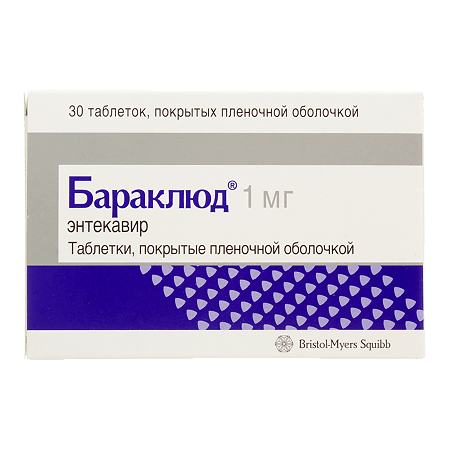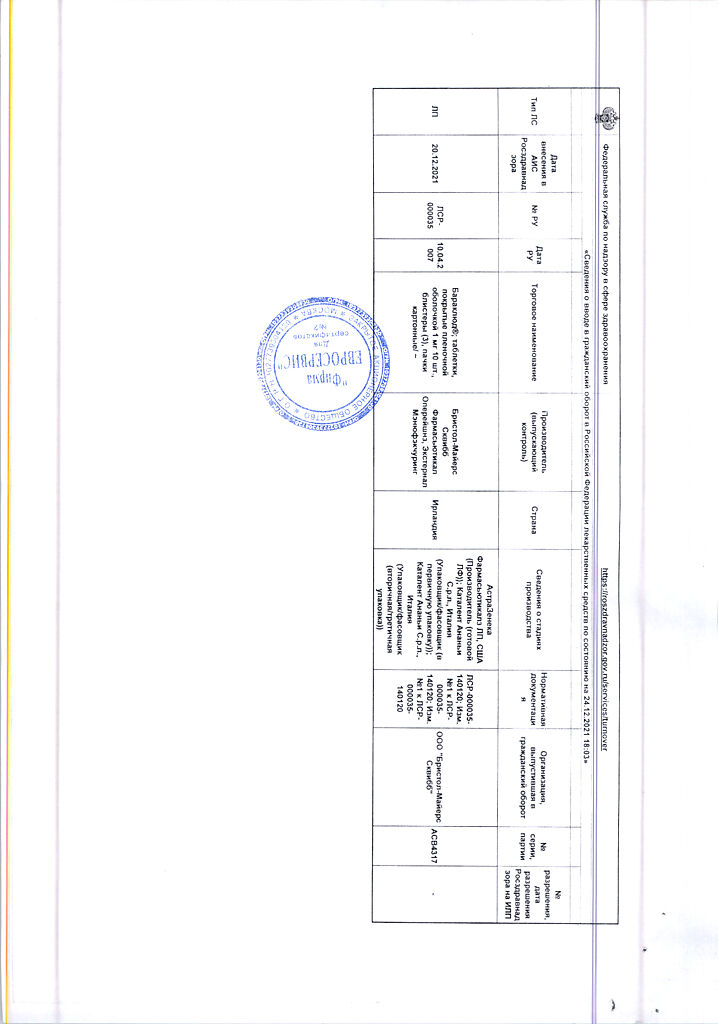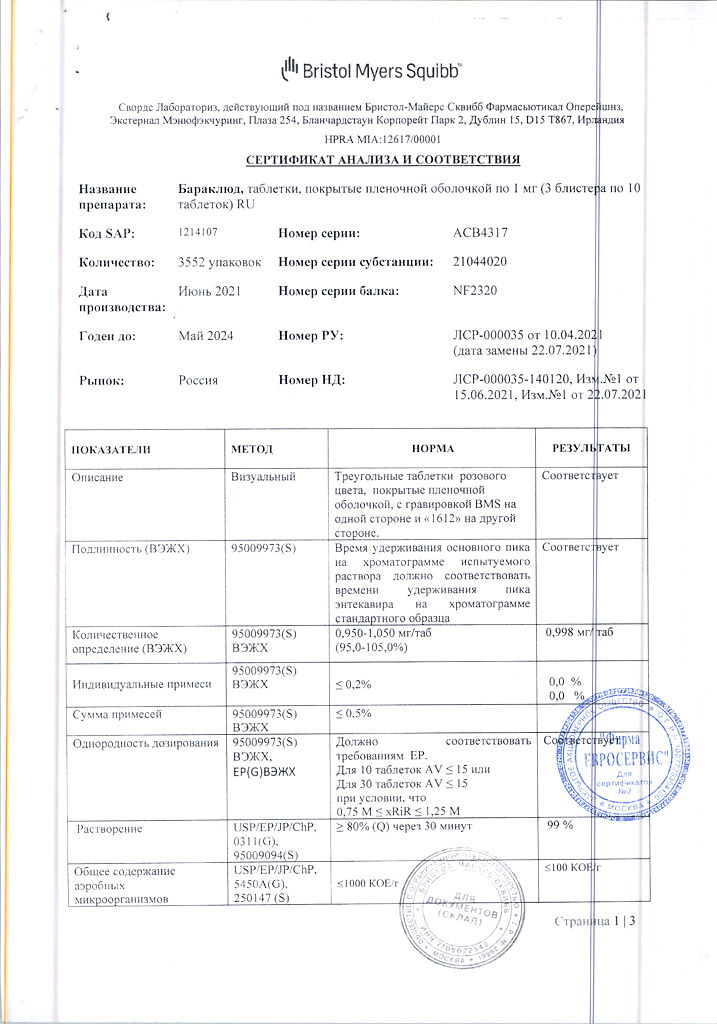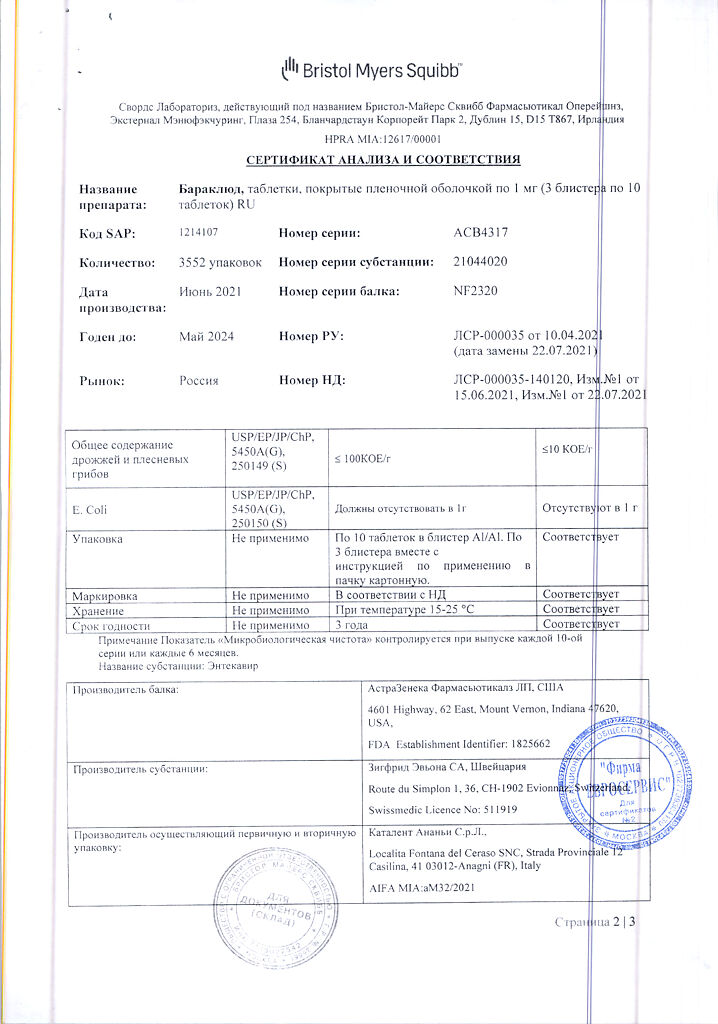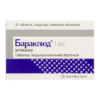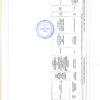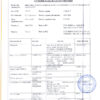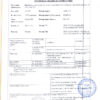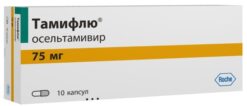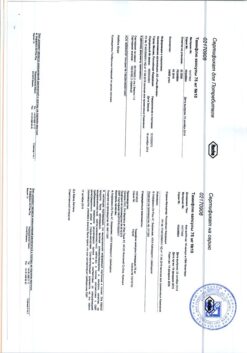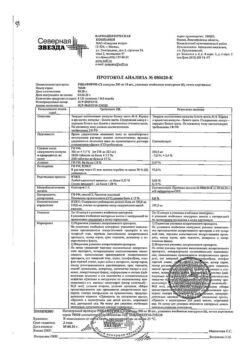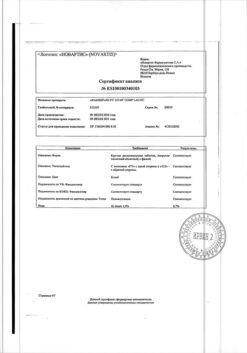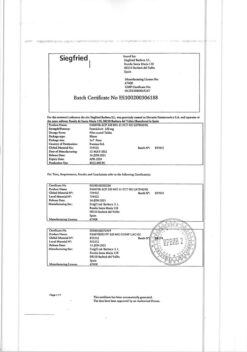No products in the cart.
Description
Pharmgroup:
Antiviral drug.
Pharmic action:
Baraclud is an antiviral drug and is an analog of guanosine nucleoside with potent and selective activity against hepatitis B virus (HBV) polymerase.
Entecavir is phosphorylated to form active triphosphate (TF), which has an intracellular half-life of 15 h. The intracellular TF concentration is directly related to the extracellular level of entecavir, and there is no significant accumulation of the drug after the initial “plateau” level.
By competing with its natural substrate, deoxyguanosine-TF, entecavir-TF inhibits all 3 functional activities of viral polymerase: (1) HBV polymerase priming, (2) reverse transcription of negative strand from pregenomic iRNA and (3) synthesis of positive strand HBV DNA. Entecavir-TF is a weak inhibitor of cellular DNA polymerases α, β and δ with a Ki of 18-40 μM. In addition, at high concentrations of entecavir-TF and entecavir, no adverse effects were noted with respect to γ polymerase and DNA synthesis in mitochondria of HepG2 cells.
Pharmacokinetics:
Absorption
In healthy subjects, absorption of entecavir is rapid, with Cmax in plasma determined after 0.5-1.5 h. When entecavir is taken repeatedly at a dose of 0.1 to 1 mg, a dose-proportional increase in Cmax and AUC is noted. The equilibrium state is reached after 6-10 days of oral administration once daily, with a plasma concentration increase of about 2-fold. Cmax and Cmin in plasma at equilibrium were 4.2 and 0.3 ng/ml, respectively, when administered in 500 mcg dose, 8.2 and 0.5 ng/ml, respectively, when administered in 1 mg dose. In oral administration of entecavir at a dose of 500 mcg with both high and low fat foods, minimal delay in absorption (1-1.5 h when taken with food and 0.75 h when taken on an empty stomach), a decrease in Cmax by 44-46% and a decrease in AUC by 18-20% were observed.
Distribution
The Vd of entecavir exceeded total body water, indicating good tissue penetration of the drug.
The in vitro binding of entecavir to human plasma proteins is about 13%.
Metabolism
Entecavir is not a substrate, inhibitor or inducer of P450 isoenzymes. No oxidized or acetylated metabolites were detected after administration of labeled 14C-entecavir to humans and rats, and few phase II metabolites (glucuronides and sulfates) were detected.
Elimation
After reaching Cmax, the plasma concentration of entecavir decreased biexponentially, with a T1/2 of 128-149 h. When taken once daily. concentration (cumulation) of the drug increased twofold, i.e. effective T1/2 was approximately 24 h.
Entecavir is excreted primarily by the kidneys, with 62-73% of the dose in the urine unchanged in the equilibrium state. Renal clearance is independent of dose and ranges from 360 to 471 mL/min, indicating glomerular filtration and tubular secretion of the drug.
Indications
Indications
Chronic hepatitis B in adults with signs of viral replication and increased levels of serum transaminases (ALT or AST) or in the presence of histological signs of inflammation in the liver.
Pharmacological effect
Pharmacological effect
Pharmaceutical group:
Antiviral drug.
Pharmaceutical action:
Baraclude is an antiviral drug that is a guanosine nucleoside analogue with potent and selective activity against hepatitis B virus (HBV) polymerase.
Entecavir is phosphorylated to form active triphosphate (TP), which has an intracellular half-life of 15 hours. The intracellular concentration of TP is directly related to the extracellular level of entecavir, and there is no significant accumulation of the drug after the initial plateau level.
By competing with the natural substrate, deoxyguanosine-TF, entecavir-TF inhibits all 3 functional activities of the viral polymerase: (1) priming of HBV polymerase, (2) reverse transcription of the negative strand from pregenomic mRNA, and (3) synthesis of the positive strand of HBV DNA. Entecavir-TF is a weak inhibitor of cellular DNA polymerases α, β and δ with a Ki of 18-40 μM. In addition, at high concentrations of entecavir-TP and entecavir, no side effects were observed in relation to γ polymerase and DNA synthesis in the mitochondria of HepG2 cells.
Pharmacokinetics:
Suction
In healthy people, the absorption of entecavir is rapid, Cmax in the blood plasma is determined after 0.5-1.5 hours. When entecavir is taken repeatedly in a dose of 0.1 to 1 mg, a dose-proportional increase in Cmax and AUC is observed. An equilibrium state is achieved after 6-10 days of oral administration once a day, while the plasma concentration increases approximately 2 times. Cmax and Cmin in plasma at steady state were 4.2 and 0.3 ng/ml, respectively, when taking the drug at a dose of 500 mcg, 8.2 and 0.5 ng/ml, respectively, when taking the drug at a dose of 1 mg. When entecavir was taken orally at a dose of 500 mcg with both a high-fat and low-fat meal, there was a minimal delay in absorption (1-1.5 hours when taken with food and 0.75 hours when taken on an empty stomach), a decrease in Cmax by 44-46% and a decrease in AUC by 18-20%.
Distribution
Vd of entecavir exceeded the total volume of water in the body, which indicates good penetration of the drug into tissues.
The binding of entecavir to human plasma proteins in vitro is about 13%.
Metabolism
Entecavir is not a substrate, inhibitor or inducer of P450 isoenzymes. After administration of 14C-labeled entecavir to humans and rats, no oxidized or acetylated metabolites were detected, and phase II metabolites (glucuronides and sulfates) were detected in small quantities.
Removal
After reaching Cmax, the concentration of entecavir in plasma decreased biexponentially, with T1/2 being 128-149 hours. When taken 1 time/day. there was an increase in the concentration (cumulation) of the drug by 2 times, that is, the effective T1/2 was approximately 24 hours.
Entecavir is excreted mainly by the kidneys, and at steady state, 62-73% of the dose is determined unchanged in the urine. Renal clearance is independent of dose and ranges from 360 to 471 ml/min, indicating glomerular filtration and tubular secretion of the drug.
Special instructions
Special instructions
When treated with nucleoside analogues as monotherapy and in combination with antiretroviral drugs, cases of lactic acidosis and severe hepatomegaly with steatosis have been described, sometimes leading to the death of the patient.
Cases of exacerbation of hepatitis after discontinuation of antiviral therapy, including entecavir, have been described. Most of these cases resolved without treatment. However, severe exacerbations, including fatal ones, can develop. The causal relationship of these exacerbations with discontinuation of therapy is unknown.
After stopping treatment, liver function should be periodically monitored. If necessary, antiviral therapy can be resumed. It should be taken into account that when prescribing entecavir to patients with HIV co-infection who have not previously received highly active antiretroviral therapy, there may be a risk of developing resistant strains of HIV.
Entecavir has not been studied for the treatment of HIV infection and is not recommended for such use,
Patients who have undergone liver transplantation. The safety and effectiveness of entecavir in patients undergoing liver transplantation are unknown. Renal function should be carefully monitored before and during treatment with entecavir in patients who have undergone liver transplantation and are receiving immunosuppressants that may affect renal function, such as cyclosporine and tacrolimus.
General information for patients. Patients should be informed that entecavir therapy does not reduce the risk of transmission of hepatitis B and, therefore, appropriate precautions should be taken.
Active ingredient
Active ingredient
Entecavir
Composition
Composition
1 tab. contains entecavir 1 mg.
Pregnancy
Pregnancy
There are no adequate and well-controlled studies in pregnant women.
Baraclude can be taken during pregnancy if the potential benefit outweighs the potential risk to the fetus.
There is no data on the penetration of entecavir into human milk.
Breastfeeding while using the drug is not recommended.
Contraindications
Contraindications
– age up to 18 years;
– hypersensitivity to the components of the drug Baraklyud.
Side Effects
Side Effects
From the digestive system: rarely (≥ 1/1000, < 1/100) - diarrhea, dyspepsia, nausea, vomiting.
From the side of the central nervous system: often (≥ 1/100, < 1/10) - headache, fatigue; rarely (≥1/1000, <1/100) - insomnia, dizziness, drowsiness.
Post-marketing data (frequency cannot be determined)
Allergic reactions: anaphylactoid reaction.
Dermatological reactions: alopecia, rash.
Interaction
Interaction
Since entecavir is eliminated primarily by the kidneys, concomitant administration of entecavir and drugs that reduce renal function or compete at the level of tubular secretion may increase serum concentrations of entecavir or these drugs.
When entecavir was co-administered with lamivudine, adefovir dipivoxil or tenofovir disoproxil fumarate, no significant drug interactions were identified.
The interactions of entecavir with other drugs that are excreted by the kidneys or affect renal function have not been studied.
Patients should be monitored closely if entecavir is co-administered with these drugs.
Overdose
Overdose
There is limited data on cases of overdose of the drug Baraklyud in patients. In healthy volunteers receiving the drug in doses up to 20 mg/day. for up to 14 days or in single doses up to 40 mg, there were no unexpected adverse reactions.
Treatment: in case of overdose, careful medical monitoring of the patient’s condition is required.
If necessary, standard supportive therapy is carried out.
Storage conditions
Storage conditions
At a temperature not exceeding 25 °C
Shelf life
Shelf life
2 years
Manufacturer
Manufacturer
AstraZeneca Pharmaceuticals LP, USA
Additional information
| Shelf life | 2 years |
|---|---|
| Conditions of storage | At a temperature not exceeding 25 °C |
| Manufacturer | AstraZeneca Pharmaceuticals LP, USA |
| Medication form | pills |
| Brand | AstraZeneca Pharmaceuticals LP |
Related products
Buy Baraclud, 1 mg 30 pcs with delivery to USA, UK, Europe and over 120 other countries.

